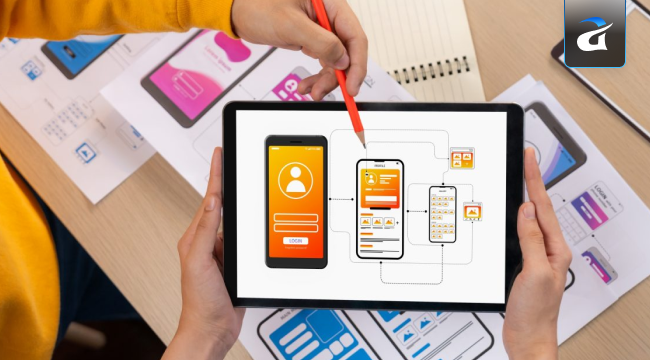You know what baffles me?
Building an app isn’t any different than cooking Chinese. Why? Because it looks surprisingly easy to do so on YouTube, but it's an absolute chaos in your own kitchen: bitter sauce, burned vegetables, and a disapproving hum floating in the air from guests. This little chaos is the exact imitation of the suffering of businesses when they choose the wrong app developer.So, let’s not beat around the bush and find out how to make sure that your app turns out Michelin-star, not “midnight-snack-gone-wrong.” It’s pretty simple: follow the right steps and choose the right development partner—let’s see how Aciano Technologies can be your best friend in this arduous expedition.

Step 1: Product clarity
First and foremost, grab a piece of parchment and ink down what you truly want in it.
Why this step matters: Developers build what you ask for. If your brief is vague, you’ll end up with a vague app (and a sad wallet).
What you must do:
The 60-second elevator pitch: Now, write a one-page summary, and in it include your target audience, core problem solved, essential features, and one success metric.
Create a short feature list: Then, make a list of features and prioritize. Consider features that must be added, should be added, can be added, and won’t be added. ?
Sketch the user flows (hand-drawn or a few slides): Show the path from opening the app to the key action.
- Decide platforms: Choose a digital platform now (like iOS, Android, Web, or cross-platform). My advice would be, in order to receive rapid validation, start with one platform or cross-platform frameworks (Flutter/React Native).
Step 2: How to hire an app developer
For hiring developers, you have to choose whether to hire freelancers, collaborate with the best app development company, like Aciano Technologies, or reach out to IT outsourcing companies.To get past any dilemma, absorb the table below:
| Model | Pros | Cons | Avg. rate per hour |
| Freelancer | Low cost, flexible, fast to start | Variable quality, harder to coordinate, single point of failure | $10–$150 (global) |
| Company | Full control, aligned long-term | High fixed cost (salaries, benefits), slower to hire | $40–$200 |
| IT outsourcing company | End-to-end, reliable process, QA and PM included | Higher cost, less direct control | $25–$49 |
If you want to find out if a staff augmentation/IT outsourcing company is really worth it over app development companies, then find out in detail: Staff augmentation vs. in-house teams.
Which to pick?
- If you have a good budget and want quick and high-quality work, then choose to collaborate with an app developing company.
- If your budget is okay, but you want good and fast work, then choose an IT outsourcing company.
- If your budget isn’t much, but you seek a suitable outcome, then freelancing is the best option for you.
Step 3: Choose the tech stack.
This step is utterly important so you could bring these things into consideration: the stack affects cost, developer availability, speed of development, and future maintenance.Checklist to choose tech:
- Match to your product goals: for heavy native graphics (games), go for native SDKs; for a simple CRUD app, head for cross-platform.
- Developer availability in your region: Sometimes, some developers are in your range, geographically, while some are not; hence, see for yourself which developers are in your range.
- Long-term cost: cross-platform lowers initial cost but might limit some native capability later.
- Integration needs: Does your app tie to existing enterprise systems (e.g., D365)? If yes, find devs with that integration experience.
Step 4: Create a clear job brief / RFP (Request for Proposal).
By having a crystal-clear job brief, you can easily reach out to the best candidates.Here’s what you should include:
- Intro to your startup: mission, team size, location, funding stage.
- Project scope: MVP features, platform, and expected delivery timeline.
- Deliverables: source code in repo, CI/CD setup, design assets, documentation, and test coverage.
- Acceptance criteria: “No critical bugs in core flow; pass X manual tests; performance <2s on average.”
- Engagement model: hourly, fixed-price milestone-based, or staff augmentation.
- Budget range: honest ranges prevent ghosting and give a realistic ballpark rather than “open.”
- Evaluation criteria: portfolio, references, technical interview, trial task.
Step 5: Evaluate developer portfolio
A portfolio indeed carries a lot of weight to check out the development skills of an app developer; it shows the breadth of your candidate’s capabilities and whether or not their claims match their work.What to do:
- Look for relevance: Do they have apps in the same domain (fintech, e-commerce, and marketplace)?
- Check live apps: Download apps they list. Use the app for 10 minutes and note performance, stability, UX, and edge-case handling.
- Ask for code samples or GitHub repos:? Look for clean structure, tests, and meaningful commit messages.
- Request client references: Ask them for any client references and ask specific questions: Did they meet deadlines? How were communications? What was post-launch support like?
- Check analytics/store stats if shared: including retention, crash rate, and rating trend—real numbers beat marketing speak.
Step 6: Technical assessment and interview
This step isn’t utilized by many, but it is highly useful if done.- Technical interview (30–60 mins): keep your focus on architecture decisions, trade-offs, prior projects, and how they tackled any fiascos. Also, don’t forget to interrogate about scalability and security.
- Behavioral interview: communication style, time-zone overlap, escalation process.
- Paid trial task (small, time-boxed, real-world): e.g., “Implement login + simple data list with pagination and error handling in 8 hours.”
Be wise and don’t use trial tasks as a free development source. Make them short and pay for the time.
Step 7: Onboarding & communication rhythm
Now that you’ve finally found someone good enough, here’s your next step:
Make a checklist for onboarding:
- Access: repos (read/write), choose a task board (Jira/Trello), staging accounts, design assets.
- Kickoff meeting: align product owner, PM, and key devs; clarify MVP and milestones.
- Define communication: Review work daily, and do about twice-weekly demos.
- Define reporting: weekly status, burndown, and risk log.
Step 8: Deployment, prototyping & post-launch support
Bear in mind that launching isn't the finish line but a very critical point in your app development journey because it’s the start of real usage and feedback.Key items:
- Deployment plan: store accounts, certificates, and rollout strategy (phased, 10% → 100%).
- Monitoring & analytics: crash reporting (Sentry), performance, and user analytics (Firebase/Amplitude).
- Support SLA: Who fixes P0/P1 bugs, and within what timeframe?
- Plan for iterative improvements: backlog grooming and user feedback loops.
The red flags (stop, look, and listen)
If you see any of these, reassess:
- No portfolio or only screenshots (no live apps).
- Refusal to do a small paid trial or provide references.
- Poor communication and collaboration for teams that must sync with you (unless you have a local PM).
- Vague contracts or refusing IP assignment.
- Unrealistic fixed-price promises without phased milestones.
Best app development tools:
- Flutter: Best for cross-platform apps with great UI (iOS + Android, single codebase)
- React Native: Best for teams who already know JavaScript/React
- Kotlin (Native/KMM): Best for near-native performance on Android/iOS
- Swift (iOS): Best for iPhone-only apps
- Android Studio: Best for Android-only apps
Hiring the right partner: what to expect from a top partner
Remember that whenever you choose a partner, you aren’t merely buying someone to “code,” but it goes beyond to buying experience, process, and the ability to scale.
So, here’s what you should expect:
- Transparent pricing and realistic timelines. Avoid partners that promise the moon in 3 weeks.
- Clear tech leadership and architecture reviews. Senior engineers should own design decisions.
- Staff augmentation option, if you want to extend your internal team with vetted developers.
- Post-launch support and handover. Source code, documentation, and knowledge transfer.
- Local/regional presence or time zone overlap—especially useful for US/Pakistan collaboration windows.
Why consider Aciano Technologies?
Aciano offers mobile app development and custom app development, and we’re also an IT outsourcing company with the keenest desire to draw out your vision into reality in the quickest time with our talented UI/UX experts, who can make the app experience a whole different level of uniqueness and smoothness.Moreover, we always make sure that you scale quickly and easily with the help of our services—if you’re a startup, you’ve definitely found your home.
The best part? It doesn’t matter if you’re as far as the USA or as close as Pakistan—we give you results on time, with no ghosting or delaying.
So, if you want your audience to get hooked onto your app or people asking you the secret to the smooth working of your app—get to us immediately!
Conclusion
Picking a developer is part detective work, part matchmaking, and part contract law—but mostly it’s about aligning expectations and communication. Therefore, it is highly important for you to find the right app developer if you wish to see your ideas coming to life right before your eyes.
Contact us and get your flawless app in the blink of an eye.
Frequently Asked Questions
How to choose the right app developer?
You should choose a developer who actually understands your idea, has a portfolio that shows that their capability can bring your vision to life, doesn’t miscommunicate, and fits into your budget.
Can ChatGPT create an app for me?
Well, ChatGPT can surely write some remarkable code, generate app ideas, and guide you step-by-step, but you must bear in mind that it cannot fully publish or deploy an app on its own. You will still need a developer or a platform to run and upload the final product.
Which app builder is best for beginners?
For first-time creators, tools like Adalo, Glide, or FlutterFlow are pretty easy to learn, as they let you build simple apps without coding and launch quickly.
What are the 7 stages of app development?
App development moves through seven steps: idea, planning, design, development, testing, launch, and maintenance. Each stage takes the app from concept to working product.
How long does it take to develop an app?
If truth be told, it highly depends on your app. But roughly speaking, a basic app can take one to three months, while a complex app can take six months or even longer than that.



